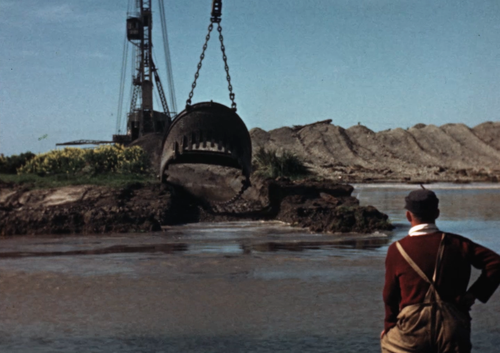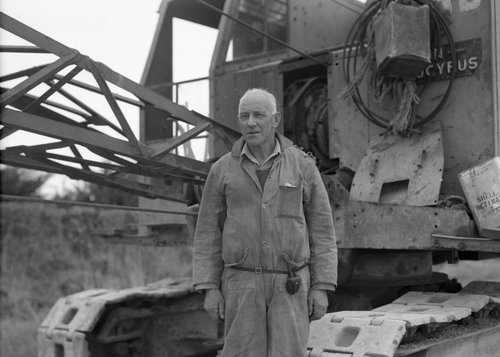
A modified version of this article was originally published in Ōtaki Today.
Ōtaki Dragline is a 30-minute recording that shows the fascinating dredging process that occurred in the Ōtaki River in the 1940s. This item was digitised for an exhibition at the Ōtaki Museum – Ko Ōtaki Te Awa – Ōtaki is the River – that opened earlier this year.
The significant dredging works were necessitated by the regularly occurring flooding that affected Ōtaki. Tracking the history of the river, an Ōtaki Historical Society Journal from 1987 notes there were serious floods in 1920, 1925, 1926, 1936 and 1940. In 1931 alone there were four floods. The major flow down from the Tararua Ranges – catchment for both the Ōtaki and Waiotauru Rivers – had defeated earlier attempts to constrain it.
Hero Image: Still from the'Otaki Dragline' film.
'Ōtaki Dragline' shows the extensive dredging operation at the Ōtaki River.
Here are some highlights:
- 3m57s – Dragline drops violently in the river in front of two workers who quickly duck away from the impending splash!
- 14m14s – Aerial cinematography of the dragline working on the river bed and the surrounding Ōtaki landscape.
- 19m57s – All aboard! Some workers jump in the claw while it is being dragged along.
- 29m33s – ‘A very impressive tracking shot of the claw,’ notes our Digital Content Editor, ‘starting up high, heading towards the camera, and making landfall – all while kept in frame and focus.’
The film shows the operation of a dragline machine. This consisted of two towers, one on either side of the river – the taller of which was 40 metres high. Between them a thick cable suspended a large bucket which would drag through the river perpendicular to the flow, scooping material from the riverbed. Each scoop could remove up to 18 tons in one pass, with this material generally being deposited to form a stop bank. This ‘scouring’ process would proceed along the river with the towers moving on rail tracks. The dragline could span a river up to 300 metres wide and their buckets made for a fearsome sight as they ploughed into the water.
Ōtaki Dragline shows the machines in action: the buckets removing large quantities of riverbed and forming new stop banks. Surveying staff monitor the progress, and scenes from an aeroplane show the large scale of the work. The film is surprisingly engaging – scenes are well selected, shots are steady and nicely framed, and the colour film is well-exposed. In amongst all the action, four men are taken for a ride in the bucket as it’s towed by a bulldozer to another location (19m57s).

Mr D. Bruce, chief dragline operator, North Canterbury Catchment Board. (Courtesy Lincoln University)
The power and might of the dragline machines compelled the government to purchase them from the United States.
Three machines were bought at a cost of £35,000 each – equivalent to $3 million in today’s money. Despite the large expense, their purchase was supported by the opposition. National Party MP for Bay of Plenty, Sir Bill Sullivan, referred to them as ‘bobby dazzlers’ – an older slang term meaning ‘a person or thing that is outstanding or excellent.’ The Minister of Public Works, Bob Semple, said, ‘I am satisfied these machines will be a blessing to the country, just as bulldozers were. These machines are able to drag through a river where human beings are unable to go, and where bulldozers would be useless.’
The draglines were used for a variety of dredging tasks around the country. Other locations initially targeted for scouring were the Orari River near Temuka in South Canterbury, and Lakes Forsyth and Ellesmere near Banks Peninsula. They were slow however to become operational as the electric motors had to be modified to work with New Zealand’s electric current.
"The power and might of the dragline machines compelled the government to purchase them from the United States."
The Ōtaki River project was finished in 1947, with the river being narrowed and the bed lowered. Since then, significant flooding events have been greatly reduced.
Can you help Ngā Taonga? A number of people are shown in this recording – both in the operation of machinery and observing the works. Do you recognise anyone? This recording comes from 1946, over 70 years ago. If you know anyone involved in this operation, or with the Ministry of Works at the time, we’d love to hear from you.
Sources for this story include Ōtaki Historical Society and Papers Past – we are grateful for these resources.